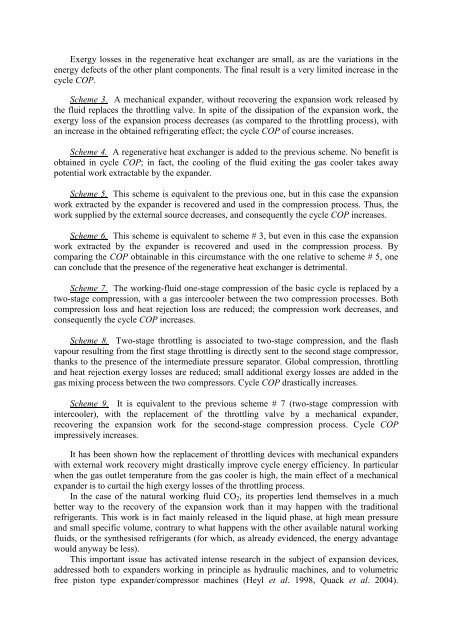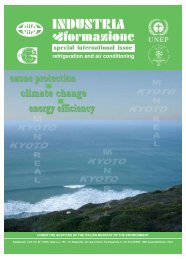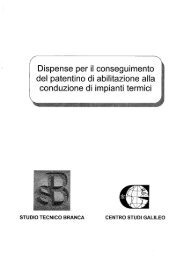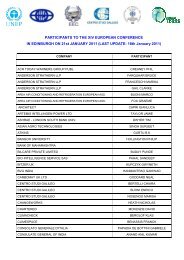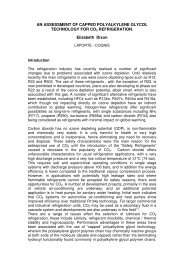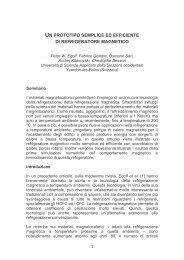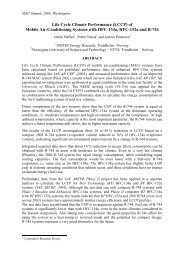PROPERTIES OF CO2 AS A REFRIGERANT - Centro Studi Galileo
PROPERTIES OF CO2 AS A REFRIGERANT - Centro Studi Galileo
PROPERTIES OF CO2 AS A REFRIGERANT - Centro Studi Galileo
Create successful ePaper yourself
Turn your PDF publications into a flip-book with our unique Google optimized e-Paper software.
Exergy losses in the regenerative heat exchanger are small, as are the variations in the<br />
energy defects of the other plant components. The final result is a very limited increase in the<br />
cycle COP.<br />
Scheme 3. A mechanical expander, without recovering the expansion work released by<br />
the fluid replaces the throttling valve. In spite of the dissipation of the expansion work, the<br />
exergy loss of the expansion process decreases (as compared to the throttling process), with<br />
an increase in the obtained refrigerating effect; the cycle COP of course increases.<br />
Scheme 4. A regenerative heat exchanger is added to the previous scheme. No benefit is<br />
obtained in cycle COP; in fact, the cooling of the fluid exiting the gas cooler takes away<br />
potential work extractable by the expander.<br />
Scheme 5. This scheme is equivalent to the previous one, but in this case the expansion<br />
work extracted by the expander is recovered and used in the compression process. Thus, the<br />
work supplied by the external source decreases, and consequently the cycle COP increases.<br />
Scheme 6. This scheme is equivalent to scheme # 3, but even in this case the expansion<br />
work extracted by the expander is recovered and used in the compression process. By<br />
comparing the COP obtainable in this circumstance with the one relative to scheme # 5, one<br />
can conclude that the presence of the regenerative heat exchanger is detrimental.<br />
Scheme 7. The working-fluid one-stage compression of the basic cycle is replaced by a<br />
two-stage compression, with a gas intercooler between the two compression processes. Both<br />
compression loss and heat rejection loss are reduced; the compression work decreases, and<br />
consequently the cycle COP increases.<br />
Scheme 8. Two-stage throttling is associated to two-stage compression, and the flash<br />
vapour resulting from the first stage throttling is directly sent to the second stage compressor,<br />
thanks to the presence of the intermediate pressure separator. Global compression, throttling<br />
and heat rejection exergy losses are reduced; small additional exergy losses are added in the<br />
gas mixing process between the two compressors. Cycle COP drastically increases.<br />
Scheme 9. It is equivalent to the previous scheme # 7 (two-stage compression with<br />
intercooler), with the replacement of the throttling valve by a mechanical expander,<br />
recovering the expansion work for the second-stage compression process. Cycle COP<br />
impressively increases.<br />
It has been shown how the replacement of throttling devices with mechanical expanders<br />
with external work recovery might drastically improve cycle energy efficiency. In particular<br />
when the gas outlet temperature from the gas cooler is high, the main effect of a mechanical<br />
expander is to curtail the high exergy losses of the throttling process.<br />
In the case of the natural working fluid CO 2 , its properties lend themselves in a much<br />
better way to the recovery of the expansion work than it may happen with the traditional<br />
refrigerants. This work is in fact mainly released in the liquid phase, at high mean pressure<br />
and small specific volume, contrary to what happens with the other available natural working<br />
fluids, or the synthesised refrigerants (for which, as already evidenced, the energy advantage<br />
would anyway be less).<br />
This important issue has activated intense research in the subject of expansion devices,<br />
addressed both to expanders working in principle as hydraulic machines, and to volumetric<br />
free piston type expander/compressor machines (Heyl et al. 1998, Quack et al. 2004).


